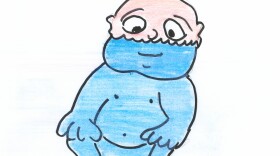
Robert Krulwich
Robert Krulwich has been called “the most inventive network reporter in television” by TV Guide.
His specialty is explaining complex subjects, science, technology, economics, in a style that is clear, compelling and entertaining. On television he has explored the structure of DNA using a banana; on radio he created an Italian opera, “Ratto Interesso” to explain how the Federal Reserve regulates interest rates; he has pioneered the use of new animation on ABC’s Nightline and World News Tonight.
Robert now reports for National Public Radio. His NPR blog, “Krulwich Wonders”, features drawings, cartoons and videos that illustrate hard-to-see concepts in science. He is also co-host of “Radiolab”, a nationally distributed radio series that explores new developments in science for people who are curious but not usually drawn to science shows. (“There’s nothing like it on the radio, “ says Ira Glass of This American Life, “It’s a act of crazy genius.”) Radiolab won a Peabody Award in 2011.
-
You've heard it a thousand times, maybe 10,000. Is there any way to make "The Star-Spangled Banner" fresh? Even fascinating? There is (Jimi Hendrix aside). Here is a new one that did it for me — the Jon Batiste version.
-
There you are in a train station, and if you stand in the right space, suddenly an angel — a lady with enormous wings, looking like the real deal — appears at your side. She's not real. She's a billboard display gone wild. Which is what a bunch of billboards have been doing lately. We visit three of the wildest.
-
They leap into the air, adjust their tails, land headfirst in the snow, burrow down and hit a teeny moving target — buried 3 feet below. It's their lunch. How does a fox catch a mouse in winter? This is amazing.
-
They look like fettuccine come to life — little flatworms that glide along riverbeds and perform miracles. Chop off their tails, they grow them back. Split them in half, they grow whole again. But chop off their heads, and not only do they grow new heads, but those new heads contain old memories! Whoa!
-
First I look in my right coat pocket. Nothing. Then my left. Nothing. Then my pants, right side — no. Then my pants, left side — yes! This is me at my front door, looking for my keys. Every day.
-
I'm thinking of a man and his cat. A real man. His real cat. Then I'm imagining a bunch of world-famous cartoonists, Calvin & Hobbes' Bill Watterson, Wile E. Coyote's Chuck Jones, Gary Larson, Maurice Sendak — all of them drawing this same man and his cat. Then I'm staring at very different men and very different cats. Then I'm giggling.
-
Reporter Emily Graslie explores natural history museums, showing us what's going on behind the scenes. Her viewers write her, of course, and in this video, she reads some of those letters. They're not about science. Or Museums. They're about Emily. And it's embarrassing.
-
Today's a day to share, so that's why I want to share this moment: Two girls are on a city street, trying to figure out who's going to be friends with the nastiest person they can think of. Not an easy problem, but they solve it. Gorgeously.
-
A fresh tomato is 93.5 percent water. A fresh baby girl or boy is 75 percent water. A banana, 74 percent. We all start wet, and then, inevitably, dry. A 1-year-old baby carries 10 percent less water; a male adult 15 percent less. Life is a slow evaporation, with some curious exceptions.
-
If we had enough time, enough brain power, the right computers, the occasional genius, is there any limit to what we can know about the universe? Or is nature designed to keep its own secrets, no matter how hard we try to crack the code? What can we never know?






